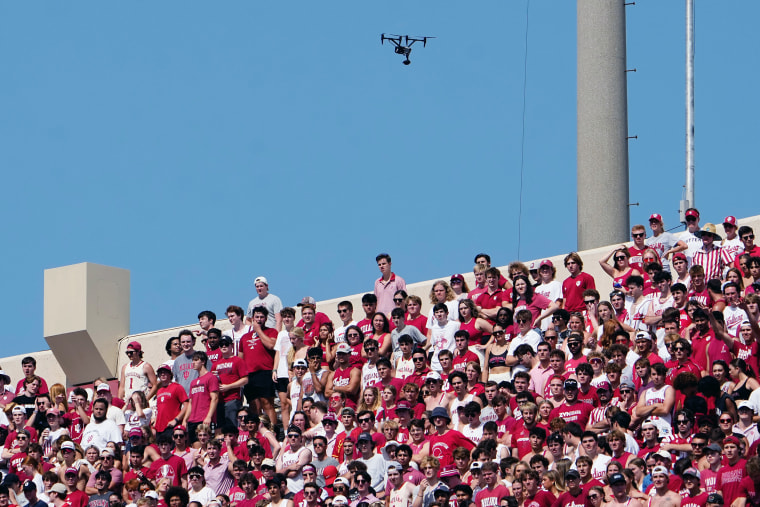When a drone was spotted over the Ohio State-Maryland college football game Saturday, officials quickly suspended the nationally televised contest and pulled the players off the field.
The interruption was brief — the drone flew off, and police tracked down and arrested its pilot, who told them he lost control of his newly bought craft as it meandered over Ohio Stadium in Columbus. He faces multiple criminal charges, but police said they found no evidence of malicious intent.
Still, the incident — the latest in a string of drone incursions over stadiums — was closely watched by executives at the NFL, other major sports leagues and members of Congress. They say it underscored a huge security vulnerability — made worse by gaps in federal law — that they fear could result in a catastrophic loss of life.
“We’re concerned about somebody who would use (drones) in a nefarious way and drop a grenade that would do considerable damage and possibly kill individuals,” said Sen. Gary Peters, D-Mich., who chairs the Committee on Homeland Security and Governmental Affairs.
Stadiums and other outdoor venues, often protected by layers of security on the ground, are mostly defenseless from an attack or mishap from above, security officials told NBC News. Even as the Russia-Ukraine war has demonstrated how easy it is to weaponize small, off-the-shelf drones, U.S. law grants only the FBI and the Department of Homeland Security the authority to jam and take down rogue aircraft, and officials say those agencies don’t have the resources to cover most major sporting events. They send counter-drone teams to the Super Bowl and the World Series, but not to regular games.

Cathy Lanier, the NFL’s chief of security, told NBC News that since 2018, when the FBI and DHS were granted drone mitigation authority, there have been 121,000 requests for them to send teams to stadiums and other venues. “They’ve been able to approve 77,” she said.
And even that limited “takedown” authority is tenuous — it is set to expire Nov. 17 when the current congressional spending bill does. Peters and other lawmakers, backed by a coalition of sports leagues, including the NFL, NCAA, MLB and NASCAR, are pushing legislation that would give state and local law enforcement agencies the authority to bring down rogue drones.
FBI Director Christopher Wray has endorsed that concept, saying in 2022 that the FBI investigated multiple instances of people trying to weaponize small drones.
Lanier said that federal law already prohibits drones from flying over major sporting events. But often there is no way to stop that from happening.
“They enter that restricted airspace, they are violating the law,” she said. “All we’re asking for is the ability to take control of that drone and move it out of our airspace.”
Lanier said there were around 2,500 drone incursions over NFL stadiums last season, up from 1,300 the year before. Last year, a Seattle Seahawks-Atlanta Falcons game was interrupted for 10 minutes when a drone flew over Lumen Field in Seattle. In 2018, a man modified a drone to drop leaflets over NFL games in Santa Clara and Oakland, both in California.
“That could have been anything,” she said. “To me, it feels like a big hole in our fence.”
A drone over a stadium could cause mayhem even if it wasn’t fitted with explosives, experts said. If spectators believed it was a threat, a panicked rush to the exits could cost lives.
“We have 70,000 people in these stadiums and arenas,” Lanier said. “If you introduce panic to that scenario, then it becomes a lot more difficult to manage. And then you have people that can be injured. So we don’t want anybody introducing anything that causes panic in the stadium.”
In 2017, a drone crashed within inches of a spectator during a MLB game between the Arizona Diamondbacks and the San Diego Padres at Petco Park in San Diego.
Lanier, who served as the police chief of Washington, D.C., from 2007 to 2016, spoke during an interview at FedExField, the Washington Commanders stadium in Landover, Maryland, a few hours before game time. Anyone trying to access the stadium had to get through a police vehicle checkpoint, and then pass through metal detectors on the way into the building. But no such security measures protected the airspace.
“I think the closest call we’ve had since I’ve been here is at the Super Bowl in Atlanta (in 2019),” she said.
Just before six Air Force F-16s were set to conduct a flyover before the game, an FBI team spotted a drone. There wasn’t time to take it down.
“Fortunately, the FBI team was able to communicate that with the flyover team and the flyover team elevated their altitude to make sure that there was no possibility of a collision.”
It’s not just stadiums: DHS told Congress in July 2022 that there had been almost 2,000 drone sightings near U.S. airports since 2021, “including incursions at major airports nearly every day.”
And Peters said Mexican drug cartels are increasingly using drones to move illegal drugs across the border.
“A wall doesn’t stop a drone from flying over with narcotics,” he said.
“We’ve got to stop kicking the can down the road,” Lanier said. “Policy is not keeping pace with technology, and that’s a problem.”
